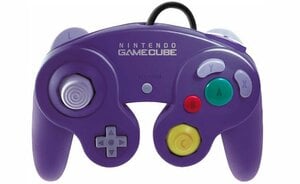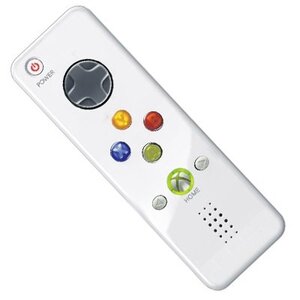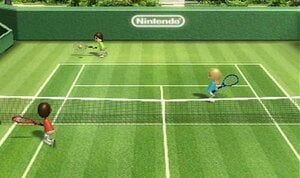
For some reason the fact that motion controls (or "gestures") are a major part of the Wii control interface bothers people; it is felt that this ruins the gaming experience and that the majority of such implementations would be better served by traditional digital button presses. Indeed some people go so far as to desire all Wii games to have support for the Classic or Gamecube controllers and not even use the packed-in Wii Remote + Nunchuk controls at all, much less the gestural component. You don't have to read too many online game previews or reviews without seeing some mention of "waggle controls" - even if the game lacks any gestural input at all!
When looking at the history of console gaming we see that for the most part controls have consisted of digital input, with the odd trackball or rotary analogue device. Many people moaning about Nintendo's choice of using gestures forget that the move to analogue thumbsticks as the default directional input device on the consoles of the mid-90s to today was similarly decried and rightly so: in the majority of cases the only purpose of analogue control is to provide some kind of unnecessary incremental movement animation for a character in a 3D action game.
Subscribe to Nintendo Life on YouTube841k
The only places it really benefits the player is in flight sims and driving games; there aren't many of the former and a thumstick is a pretty poor interface for the latter. Really you may as well still be using a d-pad and in games with a more arcade styling you'll have better results. Nevertheless Nintendo and Microsoft have both decided upon controllers with the d-pad relegated to a secondary position and without continued cries about "tacked on" analogue control.

The simple fact is that gestures are more readily grasped by people who wouldn't normally play video games, and even sceptics should agree that playing Wii Sports Tennis is more fun waving a wiimote than fiddling with a joypad. The reasons for disliking gestures due to a tacked-on nature should be focusing on developer game design, rather than the interface itself. A wiimote motion isn't more or less legitimate than a button press from a mechanical perspective - it's just a different way to send a signal - but sometimes the use of these gestures rightly deserves some criticism.
Some developers try to do too much with gestures and don't appear to recognise the limitations of the motion detection hardware in the Wii Remote and Nunchuk. The wiimote is clearly sensitive to motion as Let's Tap! attests, using vibration of the wiimote through the box it's resting upon to play the game.
The Nunchuk's detection of rotation is also good enough to be used to rotate the camera in Marvel Ultimate Alliance . However it's clear from gesture implementation in games like Godzilla Unleashed, Rampage Total Destruction and Marvel Ultimate Alliance that distinguishing between movements in opposite directions isn't quite as easily done and a motion in the opposite direction of the motion intended is frequently registered. Given the difficulty of detecting an upward or downward wiimote motion generally in these three games it's clear that further adjustment of the motion controls was required; the developers may not have taken the time or have been given the opportunity to properly implement the controls.

Failure to distinguish between motions in opposite directions is likely due to the motion being too quick for the Wii to pick up until the move back to a neutral position happens. Alternatively the motion detection sensitivity has been set so high that rapid movements are being ignored (because they overload the sensor) and more subtle return motions are picked up. Whatever the reason, it appears developers have to put more effort into tuning the controls and working around the interface limitations.
De Blob uses a downward motion to perform jumps and slam targeted enemies with great results. This appears fairly simple, but the game also successfully discerns left/right motion when jumping off the side of a building which involves motioning away from the surface your character is attached to. Deadly Creatures uses controls that accept input which is either up/down or left/right eliminating the issues associated with false detection of motion in the opposite direction and also allows users to tune the gesture sensitivity - something more developers should consider. This same game also features Quicktime sequences which call for - and detect - movement of the wiimote and nunchuk away from each other.

As well as addressing motion detection issues we should look upon use of motions for repetitive actions as a poor game design decision; not as an indictment of motion control in general. Marvel Ultimate Alliance uses a quick left-right motion as a primary melee attack; given the ongoing battles with henchmen and goons throughout the game this is clearly a poor decision and leads to rapid tiring of the forearms. Thankfully this same action can be carried out with the A button instead.
Mushroom Men also uses a wiimote wave to carry out melee attacks, but has no button alternative which suggests a lack of consideration for how long people will play the game in one sitting. Deadly Creatures was to have a similar use of motion for primary attack, but the developers made a decision to delay release of the game to swap the gesture for a button press, citing player fatigue as the reason and rightly so.
Time will tell if Microsoft and Sony embrace motion control in their future consoles and give it a position as prominent as that of the analogue thumbstick. Clearly Nintendo has made a great success of drawing in new customers who would otherwise not participate in gaming. The notion that standing and waving a remote in the air looks "daft" or "uncool" compared to sitting with a small wedge of plastic and rapidly fiddling with it appears to be a minority view given how many people have been ready and willing to mime Tennis and Bowling on their Wiis. I'm sure they would rightly regard controller fiddling as the less appealing activity.





Comments 24
Yeah, I recall being one of those A-stick luddites and I still don't see a point in the damn thing for most games (of course it did help a lot in Kururin Squash!) but at least having the cap move with your thumb instead of sliding all over the thing reduces the development of thumb pain (meanwhile Sony designed their dpad to maximize the pain...).
I do agree that the motion should be limited to rarer actions (like, say, reloading a weapon or super attacks), constant shaking is like the joystick waggle needed to play Track & Field. If you want to test the player's endurance, fine, just don't expect him to do much else or play for a prolonged period of time then.
One advantage of the motion sensor is that it's analog, few games use that though. The way you do the swing motion in Wii sports greatly affects the outcome, it's not just like hitting a button, there's variations to the input that a button cannot permit (yes, I know, technically the other consoles have analog buttons but I've seen exactly one game use that in my huge PS2 library and it did nothing but frustrate).
Motion+ will change the way motion control is perceived, I think. At the moment, few get motion controls right, even the major publishers. Only Nintendo seems to know what to do. But with Motion+ being ushered in by third parties, I feel a lot more confident in the controller's future.
Okay; you now (mostly) convinced me that analogue is useless.
It's called evolution.
It's pretty obvious that game will evolve in one form or another into a true 1:1 experience using all our senses.
Of course it's still far from that, but we can see that this is starting appening.
Ah. This is hard to tack, motion controls are nice. They let people who normally can't play, play. Here's what I think. In games that are meant to be rather casual (e.g. Wii Sports, Wii Fit) there is no need for GC/Classic add-ons to be made. But in more hardcore games I think devs should take the time to add these functions as not all of us enjoy the wiggle waggle. Oh, sometimes it works great, Galaxy for example was a good game with good motion controls. But when they have these games WHERE EVERYTHING IS TOTALLY MOTION CONTROLLED...Yeah maybe a GC/Classic add-on would be nice.
You're far too hard on analog control sticks. They do provide real and superior control for 3D games. For movement, they allow you to move at a wide variety of angles rather than being stuck to the 8 standard directions. They also allow for precision movement, something that is important in most First Person Shooters.
Analog sticks also provide an aiming mechanism. While hardly as nice as a mouse or Wii Remote, the stick allows precision control of the cursor and instant response. Something which isn't available with an 8-way dpad. (Anyone remember moving the cursor across the screen Sim City?)
The DPad has been de-emphasized not to push the analog stick, but because of a change in market priorities. The last two generations were all about pushing 3D games and content. No one felt there was value in supporting 2D anymore. Since the analog controller is a superior control for 3D work, it should come as no surprise that more emphasis was placed on it. Especially when the analog stick can do everything a dpad does; regardless of the circumstances where a dpad is superior.
On the issue of waggle, my sense is that the industry was deeply shocked by the unexpected introduction of the Wii platform. They had put a ton of time and money into their existing lines of business and simply weren't prepared for the sudden shift in mindset. Some attempted to get on board right away and use the motion controls to their fullest potential (with varying degrees of success), but other companies were left holding properties that didn't really fit the platform.
Fortunately, Nintendo provided a way out. When Nintendo ported Zelda, they added a "sword swipe" motion for using the sword. Of course, this was such a simple motion that other game makers went, "Hey, we can do that for our games too. Just use a waggle instead of a button or a true motion!" And thus the original intent of motion controls was lost and we ended up with the same old ports as always. (Plus a ton of shovelware from the PS2 that Nintendo didn't used to license.)
The Xbox controller picture just looks terrible. Anyways: motion control FTW!
I definitely thing the analogue motion to replace a dial/paddle controller is superior as Bit.Trip.Beat and Geometry Wars ably demonstrate.
I still don't really see the point of analogue outside of "floaty" controls like flight or free-looking. I, Robot was the first 3D polygon-based game and used analogue; since the game is played entirely on a 2D plane it provides no benefit at all. You could say Mario64 allows for getting closer to an edge, but frankly you've only got three stages of movement and the game doesn't actually call for that level of precision because a true 3D platformer is too hard to play simply because you cannot accurately experience a 3D world presented on a 2D screen. Invariably camera look is reduced to rotating the view on a single plane for a reason; it's not often a character moves up/down unless it's first person.
You're far too hard on analog control sticks. They do provide real and superior control for 3D games. For movement, they allow you to move at a wide variety of angles rather than being stuck to the 8 standard directions.
Just turn the camera.
They also allow for precision movement, something that is important in most First Person Shooters.
Not enough of it, FPSes on consoles are either slow paced, have barn-sized enemies or plain suck.
I like the motion controls, but I like having the option to use as many different controllers as possible, like on Mario Kart Wii. I always use the Wii Wheel when I play Mario Kart, but it is cool that people who want to use the old controller types can also do so.
It depends on the type of game and how well developers implement motion vs. traditional controls.
Don't forget the Wii's function was to introduce motion controls to people for the first time. We will alway have buttons to press as long as we have fingers but the next natural thing for people to do is gesticulate, so motion control is and has been proved to be an important next step in the evolution of control interfaces. I have a warm fussy feeling that it was Nintendo that had the balls to try it first.
Motion controls are a great add to the industry, but I've always been happy with my buttons and my analog stick, or d-pad, depends on the game; sometimes motion controls are unnecessarily used in some games, sometime developers force the controls to fit the game and as a result the motions are tiring or wrongly detected, for those games an option to use the classic controller it's very nice, but no one will ask for such an option for Mario Galaxy, where the controls are perfectly implemented; in the future the industry will get the hang of it, motion controls will be in every game together with a good convination of buttons, it will be great to use.
Analog > Wiimote.
Analog is way more precise, plus doesn't tire my arms out. Though I have no problem with some motion (Super Mario Galaxy) I definitely don't want to have games overuse motion controls, which many Wii games do (de Blob).
Analog > Wiimote. Analog is way more precise
Bingo.
Next generation might be a different story but right now the Wii remote is still the inferior control method.
Everyone seems to forget about the pointer, in my opinion, it is a great addition to the wiimote. it makes Scrolling through menus extremely easy, and can be used extremely well in some games. Super mario galaxy, Metroid, world of goo, and such. It may resemble a mouse, but in my opinion, it is different when it comes to gaming.
I prefer d-pad and waggling. Never really enjoyed analog sticks, and especially not dual. Then again, you're talking to a guy who's been mostly PC gaming since the N64 made him take a 10 year break from consoles.
I wish more games gave you the option to choose wiimote, classic, or gamecube controller. Like in Mario Kart wii.
Motion controls aren't intended to be as precise as an analog stick. It's more precise to hit the A button 2-3 times for a golf swing than to swing the remote, it's even more precise to simply enter the angle and power, even better with computer targetting assistance where you just input the target location and it computes the trajectory for you. However that's not the point of golfing.
My two cents;
First, I disagree about the quote "In the majority of cases the only purpose of analogue control is to provide some kind of unnecessary incremental movement animation for a character in a 3D action game.The only places it really benefits the player is in flight sims and driving games"
The analogue control stick makes navigating a 3-D space SO much easier, reguardless of the environment. Have you tried playing Mario 64 DS? HORRIBLE with the D-pad. The control stick isn't just there to "provide some kind of unnecessary incremental movement animation for a character in a 3D action game", it's to offer a GREATER range of movement in a 3-D environment, giving you not only up, down, left, and right, but a full 360 degree range of movement.
My second opinion is that, in some Wii games, motion control does inteed seem natural. You're right, in Wii Tennis it makes sense to wave the remote. And since it's something that you'll only be playing for short spurts anyway, it doesn't really matter how conventional it is. But, when I had to flick the remote every time I wanted Link to swing his sword or, even worse, make complex gestures to pull off combo attacks in Twilight Princess, that's a different story. Some games, you're in it for the "long-haul", and to have a traditional controller option would be welcomed. Developers should use their noggin.
i think that motion control is not very popular only because people have gotten used to analog sticks but what they fail to realise is that analog sticks were used becase there was nothing else to use at the time. the same way it went from the d pad to analog sticks, there has to be somthing after that and its motion. playing a game with your fingers seperates you from the game and is also a little barbaric. it is not the endpoint in game evolution. motion and hopefuly in the future full emersion of some kind is how we are going to playgames. granted the wiis controls arnt perfect but + is going to get it even closer. in the end, people have to realize that playing with your thumbs, just cant be that much fun or imersive.
Everyone mostly agrees on this post that with the right developer talent, motion controls can be a blast but moderation and choice should be implemented accordingly. Punch-out!! (Wii) will give gamers both options that from previews look to be both awesome control options. A bad game on the other hand is bad whether motion or traditional controls with unimaginative gameplay. So we all agree that Nintendo should hold 3rd parties to their motion standards or they must use traditional controls if need be. I'm looking forward to Pikmin 3 (announcement at E3 hopefully) and Sin & Punishment 2 that will most likely be both great motion based control games but I want my Uncharted 2: Among Thieves and Heavy Rain for PlayStation 3 this fall to have awesome traditional controls (with Sixaxis if needed). A perfect balance for my gaming needs. We all just want great games whether motion based control or traditional controls.
http://videogames.yahoo.com/events/plugged-in/report-microsoft-taking-on-wii-with-motion-controlled-camera/1313962
http://videogames.yahoo.com/events/plugged-in/report-sony-to-unveil-wii-like-controller-in-june/1310947
wii remote > analogue
Anyone played COD MW 1 or 2? Is aiming that slow in real life? I think MP3 showed the world what aiming should be like in a game! Hell even Wii Play can show the world how shooting should be done
Show Comments
Leave A Comment
Hold on there, you need to login to post a comment...